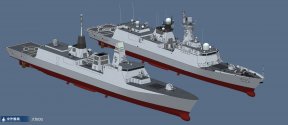Wondering if it would be possible for a squadron of multiple 054Bs to synchronize their radars in a way that would achieve 360 degree coverage at all times by merging the data from each node into a single unified view of the battlespace to approach the same tracking performance as fixed array systems.
If they have unified sensor CEC yes.
The test radar on Wuhan with the now cancelled Chinese Lantern radome, by the way, has CEC phase arrays on the stem, likely same ones we see on the 055 and on the carriers.
When the ship's fitting is done, it will be more obvious in the form of four small rectangles on each side of the mast tower, likely under the search radar.
They will be able to radar fusion with the 055s and the carriers, including the 075s. All radar data is combined into a fused track.
Another way is to have a second, small, faster rotating radar. This bill would have to be fit with the Type 368, the smaller dual sided AESA currently used on the 075. This radar should be mounted on the second mast.
If the main larger radar rotates at 30 rpm and with two sides, you have a horizontal update rate of 60 times a minute. If the smaller dual sided radar has a turn rate of 60 RPM just as its widely used predecessor, the Type 364 has, you have an update rate of 128 times.
The smaller radar will have a shorter range, but when the threat targets are both in the shared space of the larger and smaller radar, you get a combined update rate of 128 + 60.
This mode again works on the principle of sensor fusion by combining the track data from different radar systems within the ship as opposed to out of.
The third way is that the radar might have a glare and stare mode where it slows down to match the target speed. The radar panel has both electronic horizontal and vertical scanning.
4th is that active guided missiles do allow for a certain level of tracking 'looseness'. The active radar seeker is what brings the missile to the target, all it needs from the radar is to bring the missile to the 'catch basket'. Command guided, track via missile and semiactive home guidance requires much greater levels of tracking precision.
5th is that search radars will queue fire control radars which will do the fine tracking. Thats generally how traditional SAM systems work. The FCRs are responsible for guiding the SAMs. The rotating search radars do their continuous 360 degree sweep while the fire control radars are tracking targets for engagement.

